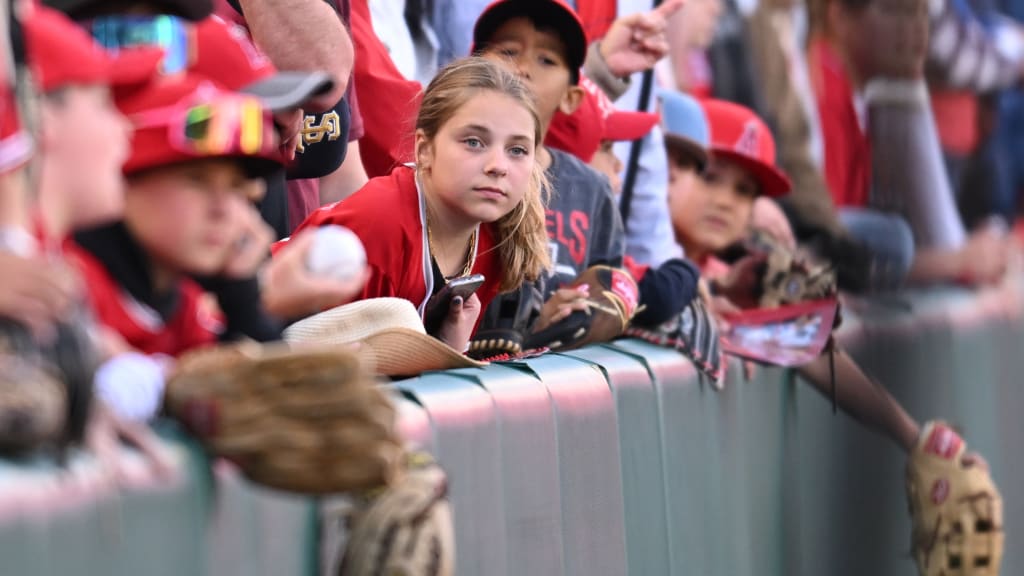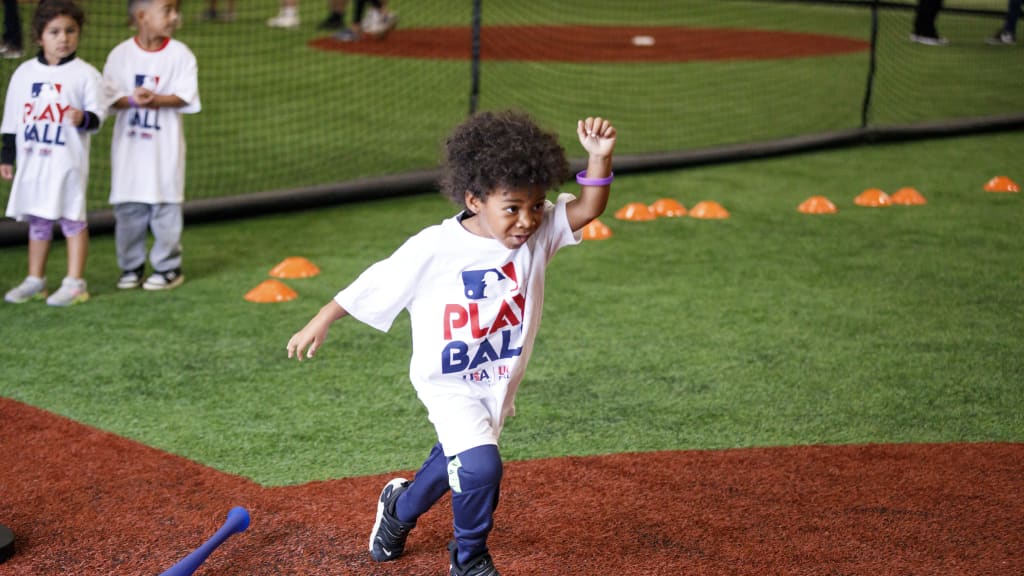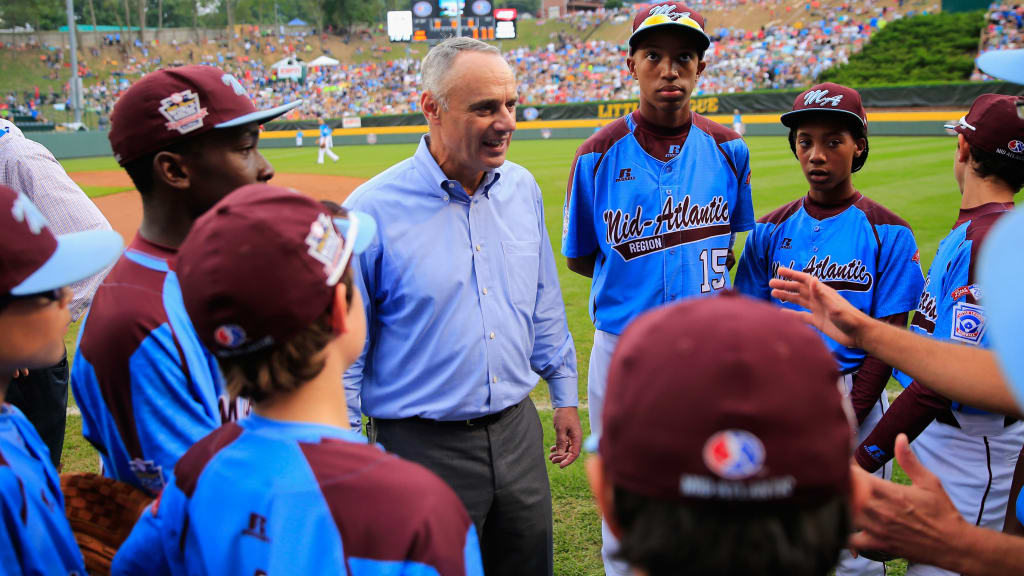
Ten years ago, the newly elected Commissioner of Baseball made his first public appearance not at a big league ballpark, but at Howard J. Lamade Stadium, the cozy little slice of baseball heaven in South Williamsport, Pa., where the Little League World Series is held.
That day in August 2014 was an intentional visit by Rob Manfred. He took the Commissioner’s Office at a time when outside voices were shouting about a supposed decline in the National Pastime and, within MLB, data revealed real concern. What began at a youth field has since sparked a remarkable turnaround in the league’s standing.
In the time since, the league has made a concerted -- and in some ways daring -- effort to reverse trends showing the average age of an MLB viewer had reached AARP territory. There is a direct correlation between baseball youth participation and fandom.
“Age,” Manfred says now, “was a big concern.” The data tells a different story now.
Over the last decade, the game has gotten younger. You see it in youth participation data. You see it in the ticket purchases, the viewership trends, the app engagements and in other, modern metrics that measure interest. You see it in the way rules changes have created a crisper, more athletic product, and in the way that product is now marketed to fans.
Here are some of the numbers that have people in the Commissioner’s Office so excited about where the game is trending:
- Viewership for fans age 18-24 on MLB.TV was up 11% in 2023. The average age of an MLB.TV viewer has dropped four years -- from 48 to 44 -- since 2018.
- Playfly Sports’ audience data shows that MLB and the NFL have nearly identical audience makeups, with 51% of their viewers under 44.
- The average age of newly created accounts in MLB’s fan database has fallen by more than seven years -- from 43.4 to 36.2 -- since 2019, and the average age of active users in that database (i.e. buying a ticket or making a purchase with the MLB Shop or streaming a game) has fallen by 1.4 years -- from 43.0 to 41.6 -- in that same timeframe.
- As detailed here, the opening of the 2024 season saw major increases in national and international viewership, record gains in social media followers and engagement and the most-watched four-day period in MLB.TV’s history.
- The median age of an MLB ticket buyer has dropped six years -- from 51 to 45 -- just since 2019, with a 9.8% increase in ticket buyers ages 18-35.
“Given the size of the samples you’re talking about,” says Manfred, “that really is a seismic change.”
MLB.TV has been streaming games since 2002 -- back when Netflix was still mailing out DVDs. And the MLB app has attracted a youthful demographic ever since it was the first sports app launched for the iPhone. But now, the numbers show the league at large catching up to that progressive technology.
So how did a league that was considered by many to be too slow, with an audience that was too old, get its groove back?
Here are four key ways in which MLB went from “dying” to thriving.

1. Youth participation
The story starts here, because this is where fandom begins.
“The data will show you that you're likely to go to four more games live per year if you played as a child,” Manfred says. “That's a huge deal.”
That’s why Manfred went to Williamsport that day in 2014. The Sports & Fitness Industry Association (SFIA) had observed a 14.5% decline in youth baseball participation in the previous five years. And so, beginning with that ceremonial association with Little League and continuing with a formal one that was initiated in 2017, MLB made its first serious forays into the youth space.
In 2015, Manfred tasked Tony Reagins, former general manager of the Angels, with heading up a newly created department of baseball development. And that year, MLB launched the Play Ball initiative.
A concept so simple -- putting a bat and a ball in the hands of kids and letting them play, independent of more formal camps or clinics or competition -- has reached an estimated 7 million kids in the time since. Play Ball’s free events are held by Major and Minor League teams, USA Baseball and USA Softball, youth baseball and softball organizations, schools (through the Fun At Bat program in physical education classes) and more than 350 cities with and without professional teams.

“We put a bat and ball in a young person’s hand, and the immediate reaction is a smile,” Reagins says. “That means they’re having fun doing what they’re doing. The chances of them wanting to do it again are strong.”
Play Ball put baseball in position to take advantage of a post-pandemic boom in youth team sport participation.
In SFIA’s recently released Topline Participation Report for 2023, baseball participation nationwide was calculated at 16.7 million -- the highest officially recorded level since SFIA’s survey of more than 120 sports began in 2008. Casual participation in baseball was at more than 8.9 million participants, an increase of 108% from 2014, the year prior to the launch of Play Ball.
SFIA also reported a 6% increase in softball participation from 2022 to 2023. The combined increase in participation for baseball and softball (+7.6%) was higher than that of basketball (+5.6%) and football (+3.6%).
“I think [participation] has gone from being an area of concern,” says Manfred, “to actually a strength for the sport.”
2. Pace/style of play
To further push the sport forward, MLB had to look backward. Back when the time between balls in play was not something fans were worried about.
MLB conducted extensive surveys of its fans, and the overwhelming response was that the game had become too bloated in game time and dead time.
“There were two clear changes fans wanted to see,” says MLB executive vice president of baseball operations Morgan Sword. “A crisper, shorter game and more action.”
Many of the analytic efficiencies that were helping teams win games were the very factors sapping the sport of much of its charm. With that as a backdrop, MLB devised a wide variety of rules change ideas, and forged a new partnership with the independent Atlantic League that allowed MLB to test everything from the automated ball-strike system to physically moving the pitcher’s mound back.
In the end, three major changes survived Atlantic League and Minor League testing -- the pitch clock (which had been used in the Minors since 2015 but was revised to include pitcher disengagement limits that eliminated loopholes and encouraged base-stealing), bigger bases and a limitation on extreme defensive shifting in the infield.
Putting all three of those rules in place at the MLB level in 2023 was arguably the most monumental set of changes in a single season in the modern era.
“Everything we were doing was attempting to restore a version of baseball that once existed,” says Sword, “rather than a new form of the game.”
It worked.
In 2023, the average time of a nine-inning game dropped 24 minutes to 2:39:49 (the shortest it had been since 1985), allowing fans to take their kids to games on school nights and fans at home to see the ninth inning without nodding off first.
The decreased time did not equate to decreased action. Quite the opposite, in fact. Runs per game climbed from 8.6 to 9.2, and stolen bases per game jumped from 1.0 to 1.4.
The reception to the rules changes was overwhelmingly positive. Leaguewide attendance eclipsed the 70 million mark for the first time since 2017, with a 9.1% increase in per-game attendance that was the largest year-over-year rise in 30 years (not counting COVID-impacted seasons). According to the Sports Business Journal, 17 teams had a rise in local TV ratings, with nine teams up by at least 25%.
A 2023 survey found that 86% of people ages 18-24 and 25-34 said they were more likely to watch MLB games due to the rules changes. At a time in which MLB is blessed with a profusion of elite young talent, the new rules put that talent in better position to showcase its skills.
“We were thrilled with the Major League players’ ability to adjust so gracefully to a new way of playing the game,” Sword says. “When we came out the other side, the great players were still the great players, and they were able to play the game more like it was played in the 1980s and 1990s and in way that was much more fun to watch.”
3. Marketing
Improving the game’s pace and style of play is paramount in keeping fans engaged with MLB. But growing that fan base also means reaching and engaging with younger audiences that might not have otherwise gravitated toward baseball.
The rule changes dovetailed nicely with an effort by MLB’s marketing team to broaden baseball’s audience with a revised advertising approach, an embrace of influencers and celebrity fans, and an emphasis on the experiential elements that make baseball special.
“The number one thing we’re trying to do,” says MLB executive vice president and chief marketing officer Karin Timpone, “is invite everybody to be a fan.”
An advertising strategy rooted primarily in a digital and social media presence meets potential young fans where they are -- on their phones.
Partnerships with influencers such as comedy group Dude Perfect, kindness evangelist MD Motivator, documentary director New York Nico, and inspirational barber Vic Blends have generated more than 250 million impressions and 19 million engagements with an audience that is overwhelmingly under the age of 35 and predominantly female. MD Motivator’s uplifting video featuring a young Phillies fan who battled brain cancer and was invited to Opening Day went viral.
“The idea is to look at the platforms that have a really strong reach to bring in the next generation of fan,” Timpone says. “We’re really specific about partnering up with voices that have a following on those platforms and bringing them closer in.”
When MLB embarked upon a new era with new rules in 2023, popular actor and avid fan Bryan Cranston helped spread the word in an ad campaign. The “Breaking Bad” star was back to hype up Opening Day this year.
Music has also helped MLB reach a younger demographic, be it Puerto Rican rapper Bad Bunny name-dropping nine MLB players in his latest album, Daddy Yankee recording an anthem for the 2023 World Baseball Classic, or MLB having an activation in the sponsor village at the Governors Ball music festival in New York.
MLB has also tried to tap into a culture that values experiences with a “Baseball Is Something Else” ad campaign that celebrates the unique aspects -- such as the smell of fresh-cut grass and the taste of a hot dog and beer in the stands on a hot day -- that separates baseball from other sports. Food has been a particularly strong vehicle to promote the game, and a partnership with restaurant discovery platform The Infatuation and its EEEEEATSCON food festivals strengthens that association.
And nothing sells the sport like the players themselves. To address the oft-uttered criticism that MLB does not do enough to market its players, the league has made it easier for players to clip their own highlights to post on social media and worked with the teams to encourage players to get their stories out to the public.
“When you’re trying to build an audience for a story or a movie or a TV show or whatever it is, you’ve got to find the angle and the hook,” Timpone says. “The diversity of talent that we have and the diversity of perspectives has really helped us a great deal in connecting and showcasing our talent in a way that brings across their personalities.”
4. Ballpark improvements
MLB has long recognized the importance of the ballpark experience in building fandom. It’s why the Commissioner’s Community Initiative donates $2.5 million worth of tickets -- more than 700,000 tickets in total -- each year to youth groups such as Boys & Girls Clubs, Make-A-Wish, schools and mentoring programs and why every club also allocates a dedicated amount of tickets specifically for Play Ball, Nike Reviving Baseball in Inner Cities and the Pitch, Hit & Run program.
“For us, the ballpark has always been a huge thing,” said Manfred. “And [the MLB audience] has always been a little younger in the ballpark than we are on TV.”
In recent years, an evolution in the ballpark experience itself has only amplified the appeal to younger audiences.
While the on-field product is and will always remain the most important entertainment element of that experience, mixed-use ballpark districts (such as those that surround the Braves’ Truist Park, the Cardinals’ Busch Stadium and the Rangers’ Globe Life Field), renovations centered around social-gathering spaces (such as those that reshaped the Rockies’ Coors Field, the Guardians’ Progressive Field and the Blue Jays’ Rogers Centre) and creative subscription packages (as opposed to traditional season tickets) have drawn in more casual and even non-baseball fans.
“The clubs were proactive in terms of what your in-ballpark experience is like,” Manfred says. “They were ahead of or at least consonant with the changes about stand-up bars and alternate ways to watch a game, as opposed to planting yourself in a seat.”
That ballpark experience has been further enhanced by a more balanced schedule in which every team has at least one series against every other team. That means that every team (and their All-Star players) will visit your team’s park no less than once every two seasons. And a more integrated structure in which MLB has its partnerships in the amateur space and now operates Minor League Baseball gives the league a leg up in making its players national household names.
“The alignment in the sport is much better, I think,” Manfred says. “We’ve put ourselves in a position to market our players from the Draft through their debut in the big leagues, and then ultimately their big league careers. Those are all huge positives for us.”
